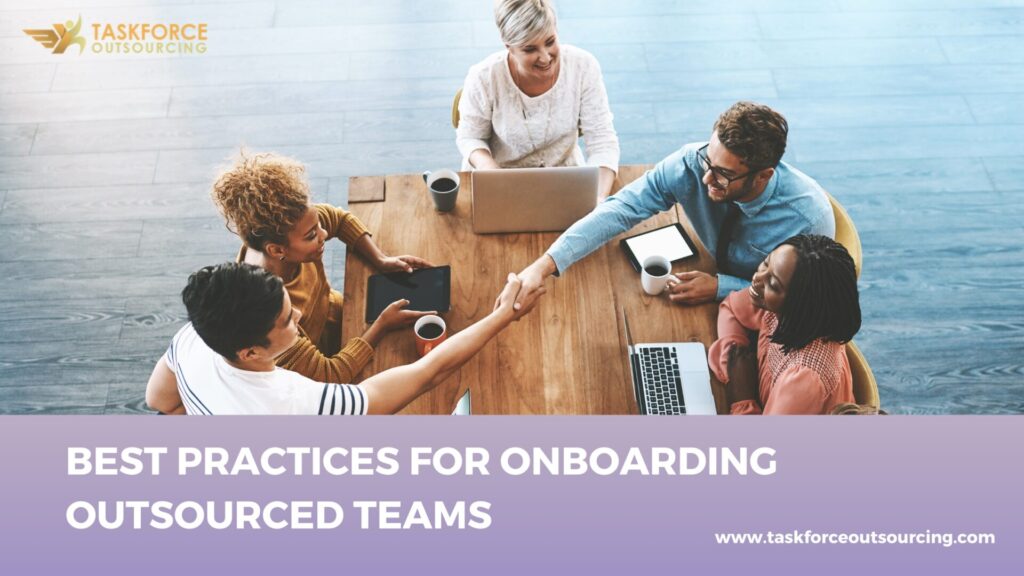Businesses are spending more and more on outsourced teams in today’s worldwide market to take advantage of specialised talents, cost savings, and round-the-clock productivity. Effective onboarding of outsourced teams is crucial to guarantee their seamless integration into your organisation and their ability to support your objectives. The following are the best ways to onboard teams that are outsourced.
Contents
- 1 1. Create a thorough onboarding plan.
- 2 2. Define Your Expectations and Goals
- 3 3. Offer the Resources and Tools That Are Required
- 4 4. Encourage Effective Communication
- 5 5. Promote Collaboration in the Workplace
- 6 6. Monitor and Evaluate Performance
- 7 7. Guarantee Security and Compliance
- 8 Conclusion
- 9 Frequently Asked Questions (FAQs)
1. Create a thorough onboarding plan.
Create a thorough onboarding plan that includes the following before your outsourced team begins working:
- Roles and Responsibilities: Clearly state each team member’s expected behavior.
- Important Contacts: Provide a list of the key individuals in your company to contact with various questions and demands.
- Communication Protocols: Decide on preferred means of communication, dates and hours for meetings, and turnaround times.
2. Define Your Expectations and Goals
Share with the outsourced team the objectives and timeline from the beginning. This includes:
Project Goals
Outline the objectives, significant dates, and outcomes of the project.
Performance criteria
Describe the deadlines and quality criteria that the team needs to adhere to.
Reporting Requirements
Indicate when and how progress reports are to be sent.
3. Offer the Resources and Tools That Are Required
Provide the necessary resources and tools your outsourced team requires to complete their work effectively:
Software and System Access
Find out that the group has the required software, systems, and documentation available to them.
Training Materials
Offer materials for instruction, including guides, video lessons, and manuals.
Technical Support
Provide connections for technical support in case problems with tools or systems occur.
4. Encourage Effective Communication

Plan regular check-ins to go over updates, work through problems, and give feedback in order to guarantee successful collaboration with your outsourced staff. For smooth communication, make use of services like Slack, Zoom, or Microsoft Teams. Furthermore, exhibit cultural awareness by arranging meetings at times that work for everyone involved, taking into account time zones and cultural variations.
5. Promote Collaboration in the Workplace
Staff Introductions
Set up online get-togethers to acquaint your internal staff with the outsourced crew.
Emphasise the significance of the outsourced team’s contribution to the achievement of common objectives.
Common Objectives
Inclusivity
Be inclusive by including the contracted staff in celebrations and team-building exercises.
6. Monitor and Evaluate Performance
Monitor your outsourced team’s performance to make sure it’s in line with your company objectives:
- Performance Metrics: Define precise metrics for assessing the group’s output.
- Frequent Feedback: Acknowledge accomplishments and offer constructive criticism on a frequent basis.
- Continuous Improvement: Determine what needs to be improved and, when necessary, provide more resources or training.
7. Guarantee Security and Compliance
Uphold security and compliance requirements when collaborating with external teams:
Non-Disclosure Agreements (NDAs):
To safeguard confidential information, require team members that are outsourced to sign them.
Security Protocols:
Establish strong security standards to protect information and intellectual property.
Compliance Training:
You must ensure the workforce that is being outsourced understands and complies with the legal and ethical obligations specific to your business.
Conclusion
Effective onboarding of outsourced team members can greatly increase the output and performance of your company. You may successfully integrate outsourced teams into your company by creating a thorough onboarding plan, outlining expectations, allocating the required resources, promoting effective communication, promoting collaboration, keeping an eye on performance, and guaranteeing compliance. By implementing these best practices, you can create a solid, cohesive team that advances the objectives of your company.
Frequently Asked Questions (FAQs)
A: The first thing to do is draft a thorough onboarding strategy. Roles and duties, important contacts, communication procedures, project goals, and performance standards should all be included in this plan. An organised plan lays the groundwork for a seamless onboarding procedure.
A: Establish preferred channels of communication (such as Zoom, Microsoft Teams, and Slack), plan frequent check-ins, and be culturally aware of time zones and communication preferences in order to guarantee clear communication. Building alignment and trust is facilitated by open and constant communication.
A: The required software and systems, training resources (such as guides and tutorials), and technical support contacts must be available to your outsourced workforce. Having these tools available guarantees that the group can work productively and successfully on the tasks at hand.
A: Share the goal of the project, important checkpoints, and success indicators right away. Describe the deadlines and quality criteria that the team must adhere to. You should also outline the reporting requirements, including the manner and timing of progress updates.
A: Organise virtual get-togethers to introduce the outsourced team to your internal team, emphasise common goals, and include the outsourced team in celebrations


